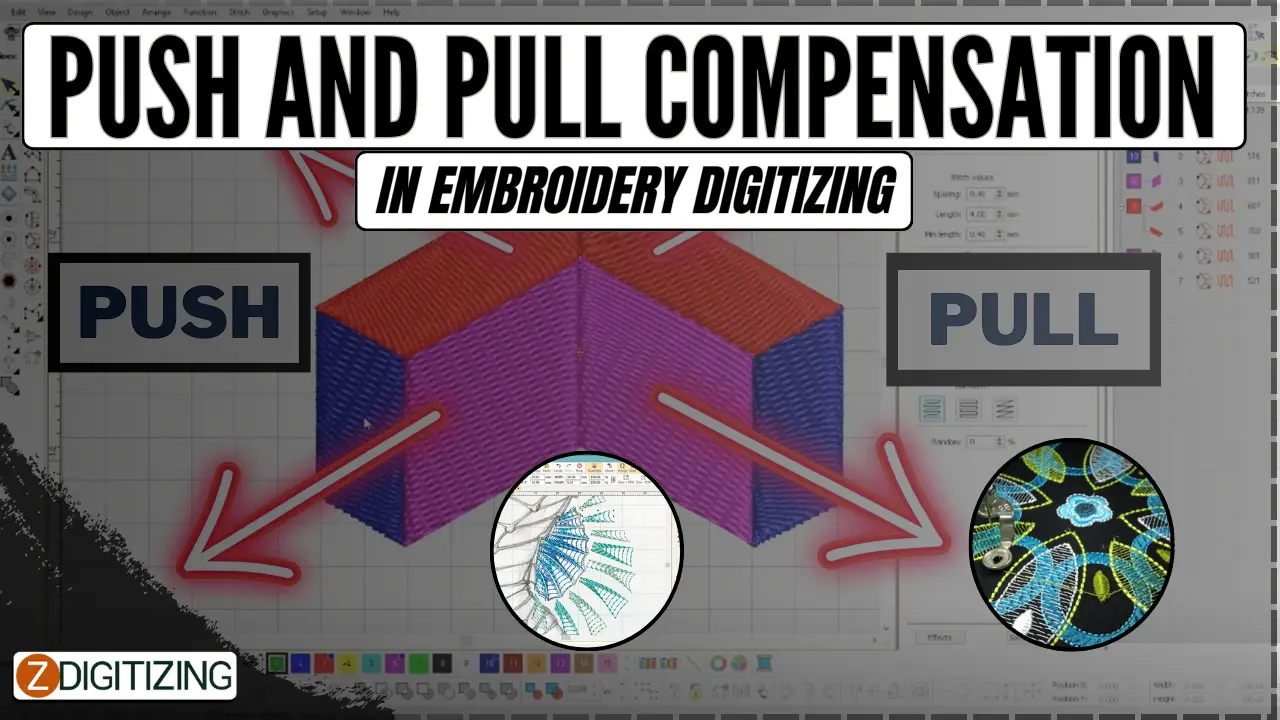n the world of embroidery digitizing, precision is paramount. Every stitch must be calculated to ensure that the final embroidered design is as close to the original artwork as possible. However, when it comes to translating digital designs into embroidered reality, there are factors that can affect the accuracy of the final product. One of these factors is push and pull compensation.
What is Push and Pull Compensation?
Push and pull compensation refers to the adjustments made to compensate for the natural tendencies of fabric to stretch or compress during the embroidery process. When a design is convert to embroidery file and stitched onto fabric, the stitches themselves can exert forces that cause the fabric to shift or distort slightly. Push and pull compensation techniques aim to counteract these forces to ensure that the final embroidered design maintains its intended shape and alignment.
Importance in Embroidery Digitizing Service
In the realm of embroidery digitizing service, push and pull compensation is essential for achieving accurate and high-quality results. Without proper compensation, embroidered designs may appear distorted or misaligned, detracting from their overall visual appeal. By understanding and implementing push and pull compensation techniques, digitizers can ensure that their embroidered designs faithfully replicate the original artwork with precision and clarity.
How Push and Pull Compensation Works
Push and pull compensation techniques typically involve making adjustments to the digital embroidery file to account for the inherent stretching or compressing of the fabric during stitching. These adjustments may include:
-
Underlay Stitching: Adding additional stitches underneath the main design to stabilize the fabric and minimize distortion.
-
Stitch Direction: Adjusting the direction of stitches to minimize the effects of stretching or compression on the fabric.
-
Stitch Density: Increasing or decreasing the density of stitches in certain areas to compensate for fabric movement.
-
Stitch Length: Modifying the length of stitches to accommodate the characteristics of different fabrics.
-
Tension Adjustment: Fine-tuning the tension of the embroidery machine to ensure even stitching and minimize fabric distortion.
Benefits of Push and Pull Compensation
Proper push and pull compensation offers several benefits in the embroidery digitizing process:
-
Improved Accuracy: Compensation techniques help ensure that embroidered designs closely match the original artwork, maintaining the integrity of the design.
-
Enhanced Quality: By minimizing distortion and misalignment, push and pull compensation techniques result in higher-quality embroidered products with crisp, clear details.
-
Reduced Production Time: By reducing the need for manual adjustments and re-stitching, push and pull compensation can streamline the embroidery process, saving time and resources.
-
Greater Customer Satisfaction: Accurate and well-executed embroidery designs are more likely to meet or exceed customer expectations, leading to greater satisfaction and loyalty.
Challenges and Considerations
While push and pull compensation techniques are highly effective in minimizing fabric distortion, they are not without their challenges. Digitizers must consider factors such as fabric type, design complexity, and machine capabilities when implementing compensation strategies. Additionally, fine-tuning compensation settings may require trial and error to achieve optimal results.
Conclusion
Push and pull compensation is a critical aspect of embroidery digitizing, ensuring that embroidered designs maintain their intended shape and alignment. By understanding the principles of push and pull compensation and implementing effective techniques, digitizers can achieve accurate and high-quality results in their embroidery projects.
Unique FAQs
-
Why is push and pull compensation important in embroidery digitizing?
- Push and pull compensation helps counteract the stretching or compressing of fabric during the embroidery process, ensuring that embroidered designs maintain their intended shape and alignment.
-
How does push and pull compensation affect the quality of embroidered designs?
- Proper push and pull compensation results in higher-quality embroidered products with improved accuracy, clarity, and detail, enhancing the overall visual appeal of the final product.
-
What factors should be considered when implementing push and pull compensation techniques?
- Fabric type, design complexity, machine capabilities, and tension settings are important factors to consider when implementing push and pull compensation techniques in embroidery digitizing.
-
Can push and pull compensation be automated in embroidery digitizing software?
- Some embroidery digitizing software offers automated push and pull compensation features, allowing digitizers to adjust compensation settings quickly and easily based on fabric and design characteristics.
-
How can I learn more about push and pull compensation techniques in embroidery digitizing?
- Embroidery digitizing courses, tutorials, and forums are valuable resources for learning about push and pull compensation techniques and gaining practical experience in implementing them effectively.


No comments yet